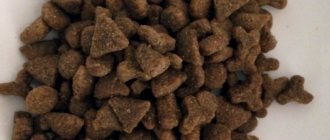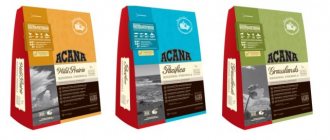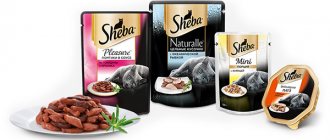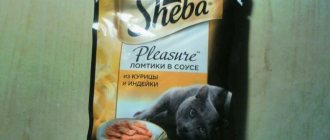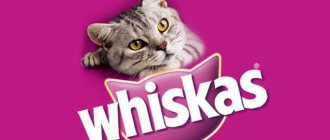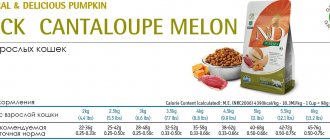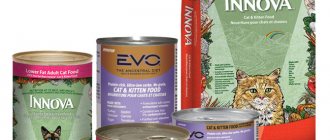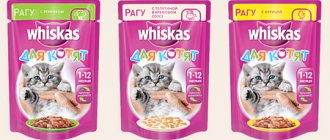Home » Useful Information
Whiskas for kittens is a balanced diet with all the necessary vitamins and microelements.
took care of creating both wet and dry food lines that are suitable from the first months of life. However, can a kitten have Whiskas from the first months of life?
- 2 Feed composition
- 3 Advantages and disadvantages of Whiskas feed
- 4 Specifics of food for kittens
- 5 Reviews and recommendations
- 6 Conclusion
Review of Whiskas food for kittens
Many owners of adult mustachioed tabbies, although they deal with ready-made food, have very different opinions on whether a kitten can have Whiskas.
Some argue that it is best to give babies only natural food, while others say that Whiskas for kittens (dry and wet) has a balanced food composition and is optimal for the smallest.
Even such little ones can be given pate, jelly or Whiskas stew
First of all, it is worth noting that food can be dry or wet.
Whiskas dry food for kittens has the following advantages:
- reducing the risk of tartar formation, the development of periodontal disease, maintaining the condition of teeth;
- contains the optimal amount of fiber, which is necessary for the normal functioning of the digestive system;
- does not spoil longer than wet food.
In the morning - stew, in the afternoon - pillows, in the evening tender pate... With such a diet it’s a sin to complain
Whiskas wet food for kittens has positive aspects:
- minimizes the risk of overeating;
- the water balance in the animal’s body is normalized;
- reduces the risk of urinary system diseases;
- Suitable from 1 month of life and ensures the smoothest possible transition from breast milk to solid food.
The entire Whiskas line includes 7 products:
- chicken pate;
- jelly with veal or turkey;
- stew with salmon, lamb or chicken;
- Whiskas for kittens dry food: pads with turkey and carrots.
Chicken pate can be added as complementary foods from the 5th week.
It combines the optimal amount of nutrients, vitamins and minerals.
In addition to vitamin E, which supports the body’s protective functions, the food also contains calcium, beneficial acids (omega-6), zinc, vitamin A, and taurine.
Its main advantage is its ease of absorption.
Veal or turkey jelly consists of small pieces of meat in jelly. Like pate, it can be added to the diet starting from 1 month of life.
With such a variety you can twist your nose
The stew series has three varieties:
- chicken;
- salmon;
- lamb.
Instead of jelly, the pieces of meat are seasoned with sauce.
Hard pads for babies from 2 months of age
If wet types of food are intended for feeding kittens from the first month, then dry food is recommended from at least two months of life.
What are the consequences
Feeding your pet with ready-made food is quite simple, quick and inexpensive. However, few owners think about the possible consequences of such a diet for their pet.
Veterinarians point to the following diseases and pathological conditions that develop in cats whose menu is based on Whiskas and other economy-class foods:
- gastritis;
- ulcerative lesions of the gastrointestinal tract;
- bouts of vomiting;
- liver pathologies;
- development of dependence on food, refusal of other foods;
- kidney diseases;
- sand and stone formations localized in the kidney area;
- hair loss;
- skin, dermatological diseases;
- lethargy, passivity;
- development of obesity;
- the appearance of dandruff and skin rashes;
- pancreatitis.
Clinical studies have shown that cats fed Whiskas require more water. Thus, when eating 100 g of food, an animal must consume at least 250 ml of liquid, which is virtually unrealistic. Lack of proper drinking regime leads to serious problems with the kidneys and urination, increased urine concentration, and the formation of sand and stones.
If you constantly feed Whiskas to a small kitten, you can provoke delays in its development, a weakened immune system and an increased susceptibility to various kinds of diseases. Possible unwanted side effects include allergic reactions.
We suggest you read: How to treat a cat with poisoning
The results of the studies have proven that domestic cats that feed exclusively on Whiskas and often consume this food live on average no more than 5 years. At the same time, the average life expectancy of cats whose owners provide an optimally balanced menu is at least 10-15 years.
Feed composition
The composition of feed is varied and depends on both type and taste.
The pate includes the following components: at least ¼ - chicken, meat and offal, taurine, vitamins, minerals, vegetable oil.
Ingredients of jelly with veal or turkey:
- meat and offal, in particular veal/turkey, must make up at least 4%;
- vegetable oil;
- vitamins A, E;
- minerals;
- taurine
Whiskas for kittens (dry) “tasty pads” with turkey and carrots has the following food composition:
- wheat flour;
- animal meal (poultry meal, turkey meal);
- meat and bone meal;
- rice;
- animal fats;
- protein plant extracts;
- vegetables;
- sunflower oil;
- Brewer's yeast;
- dairy products;
- vitamins;
- minerals;
- taurine
Advantages and disadvantages of Whiskas feed
It is difficult to find ready-made food for animals that is completely natural and will prevent the development of any diseases in the future.
Positive aspects of Whiskas food for kittens:
- pets eat food with pleasure;
- a wide range of flavors and types;
- price.
Master... You gave me something wrong... Is it for teeth?
At the same time, many people talk about the presence of completely unhealthy additives, and some pets get so used to these foods that they don’t want to eat anything other than them.
The negative aspects of this food include:
- presence of additives, preservatives;
- if Whiskas kitten food is chosen incorrectly, there is a risk of developing urolithiasis;
- addiction.
Brand history
Whiskas was the first animal food product to be commercialized by the American company Mars. This happened in 1932, and now in terms of sales it is in first place among industrial diets for cats in the world. Divisions of this company are located all over the world, but the main representative office of Mars Petcare is located in Belgium, in Brussels. In 1991, the company began operating in Russia, and already in 1995, the first plant for the production of food for pets opened in Stupino. At the moment, there are already several feed production factories in the Russian Federation.
The pride of the company is the Waltham research and development center, located in the UK. Leading experts in the field of veterinary medicine and pet nutrition are developing new concepts that are used in ready-made food formulas for cats. One of the most famous achievements of this laboratory is the recognition of the important role of taurine in the body of cats.
Cats are not able to produce this substance on their own and can only get it from food, so Whiskas was the first food to which it was added. This was a significant breakthrough in the field of ready-made diets for domestic cats. Currently, all complete feeds include taurine.
Specifics of food for kittens
British, Scottish, Abyssinian or any other popular breed has appeared in your home .
The first vaccinations have been done, the toilet , scratching post and even the cat's house have been prepared. There is one more question left: what to feed the kitten?
Important! The health and good mood of a pet depend 100% on how responsibly its diet is chosen for the coming year.
Hey master! I got into the bag! Where's the food?
Regular table food is completely unsuitable for a pet’s fragile and immature body.
Even products that are known for their benefits should not be used to feed kittens.
After all, their digestive system is completely different from that of humans.
And since not everyone has time to cook specifically for their pet, ready-made food can save the situation.
It’s just worth purchasing food not for adult cats, but for babies up to 1 year old.
One of the popular feeds is Whiskas, which belongs to the economy class.
As the manufacturers assure, it is suitable for both short-haired and long-haired breeds from the 5th week of life.
If Whiskas food for kittens is chosen for nutrition, in the first year of life it is recommended to adhere to the following scheme:
- Up to 1 month - mother's milk.
- From 1 to 3 months - mother's milk begins to be replaced with wet food. It is preferable to start with Whiskas pate. From the second month, in addition to wet types, you can also give dry pads. If the kitten has a hard time eating them, it is recommended to soak them a little in warm water. Number of meals – 6.
- From 4 to 5 months – it is necessary to gradually reduce the number of meals to 3-4. The optimal regimen is 2 meals of wet food (morning and evening) and 1 meal of dry food.
- From 6 to 12 months – it is recommended to continue the 2+1 scheme.
How to give
If a kitten eats Whiskas no more than once a month, then there should be no consequences for its body. It happens that a kitten has to be left at home alone for more than half a day, then Whiskas is suitable as a one-time meal. It’s just important not to forget to leave him enough water. For such a case, Whiskas will be very useful.
Interesting video:
But it is not recommended to purchase it for a kitten as a treat, even occasionally. It is better to give him a natural treat that will benefit the small, vulnerable organism.
Reviews and recommendations
Reviews of Whiskas food for kittens vary widely: some owners say that the animal eats with pleasure, is always in a playful mood, and examinations by the veterinarian always go without any complaints.
Here are some reviews about these foods:
Ruslana, Yekaterinburg: “ We were looking for inexpensive but high-quality food for our British kitten. We've been buying food for him for some time now - he eats on both cheeks. Of course, when our Brunik grows up, we will again look for some options for mixtures, but now Whiskas is quite happy with him.”
Alexander, Stavropol: “ At first, my wife and I didn’t really believe that the advertised Whiskas was a really good food, but the pet store convinced us otherwise. The cat eats with pleasure, and it’s not hard for us financially, so it’s a big plus for the manufacturer for budget-friendly and good food.”
Marina, Kiev: “ We have a Persian cat in our family, Monya, who has been very picky about food since she was a little girl. Of course, now she eats “adult food”, but when she was still a kitten, she was very picky about food, and only Whiskas accepted it. As for the quality of the food, there are no complaints about the cat’s health.”
Reviews from veterinarians indicate that for normal development, both dry and wet food for Whiskas kittens are needed.
Important! Alternating dry and wet food ensures the achievement of an optimal nutritional pattern for the full development and good health of your pet.
Which one to choose? Although, why bother? You have to eat both!
It is optimal that accustoming to alternating changes of feed occurs from childhood.
Manufacturers of Whiskas kitten food recommend following a dry diet during the day, and giving jelly, stew or pate in the morning and evening.
Regardless of what breed your pet is, be it a bohemian Persian , a bald Don Sphynx , or a huge Maine Coon , the main thing for him in the first year of life is a balanced diet.
In the first month of life, babies are not separated from their mother. Their only food is mother's milk.
In the period from 1 to 3 months, they try to feed babies and completely switch them to ready-made food.
During this period of life, Whiskas wet food for kittens is better for them.
From 4-5 months until they reach the age of one year, the diet can be diversified with dry food.
Whatever breed of purr you have, you should take care of its balanced diet. After all, this is the key to health
Veterinarians' opinion
If you listen or read reviews from veterinarians, you can see that almost all of them agree that Whiskas should not be fed not only to kittens, but also to adult cats. No matter what kind of food (wet or crushed dry) a kitten is given, it will not grow up healthy. Sooner or later he will begin to have health problems, because the daily portion of Whiskas contains a tiny amount of protein (only 5%) and harmful chemicals.
Of course, there will be people who are ready to argue with this, and will give more than one example of how cats eat only Whiskas for years and feel great without any health problems. But before drawing any conclusions, it would be a good idea to carefully analyze such cases. Most likely we are talking about non-pedigreed cats, since their bodies are resistant to even the most severe influences. And in fact, such animals can live 5-7 years without illness, eating low-quality food. But then they will still start to get sick and will live no more than 9 years, not reaching the required 15.
Interesting video: Whiskas kills cats
An owner who loves his pet and wants it to grow up active and healthy will never skimp on its food. He will choose expensive ready-made premium food or will feed the animal with good quality natural food, which will be healthier than any ready-made food.

